Gateway to Hell
A few years ago, I wrote a long piece on the virtues of small lots (small parcels in the lingo), and asked whether it’s possible for us all to think differently about large development efforts and plans. Can we truly value the small, incremental change instead of the big, “catalytic” change? It’s been one of my more widely-shared posts over the years, which I suppose means it’s connected with quite a few people. Here’s a section of the piece I’d like to revisit, in connection with a project local to the Kansas City market:
Very often today we still default to those large, single-developer projects as a private and public solution to development. We do so for a variety of reasons, not the least of which is that most cities now have a nearly impenetrable maze of development regulations that effectively weed out the artisan, small-scale developer. And, because it’s just easier for all of us to wrap our heads around one, large project instead of the complex nature of how many small projects might happen over time.
As a result, our cities often see projects that build 200-400 apartments at once, take years to put together, and disappoint architecturally. Some examples of instant urbanism are certainly better than others. But most of them not only feel artificial, they also have ownership from a very small number of large companies. Big deals are complicated and take a long time, and lend themselves to entities that have enough size to sustain delays and complications.
Last week came an announcement regarding the new version for a very troubled project in the inner ring suburb of Mission, Kansas. Here’s the short version:
The latest iteration of the $268 million Mission Gateway project is moving forward following a key vote Wednesday night.
Now the question is: will developers finally complete it?
The Mission City Council on Wednesday approved changes to the tax increment financing plan and Community Improvement District ordinances, as well as a final redevelopment agreement for the fifth version of the project.
With those hurdles now cleared, work could finally resume later this year on the site at the intersection of Johnson Drive, Shawnee Mission Parkway and Roe Avenue.
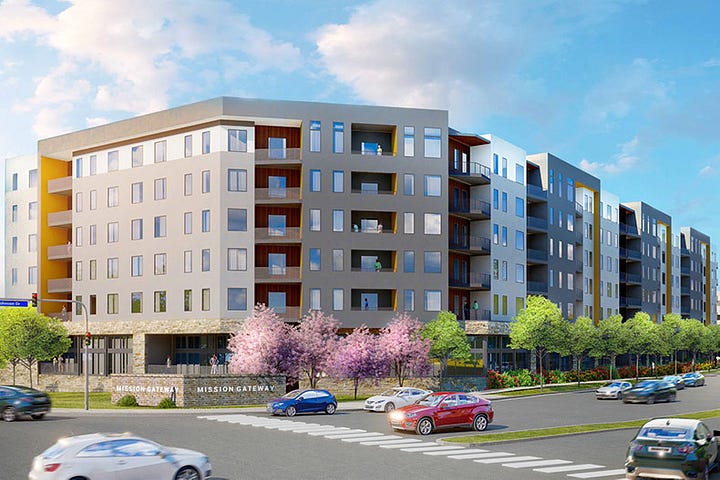
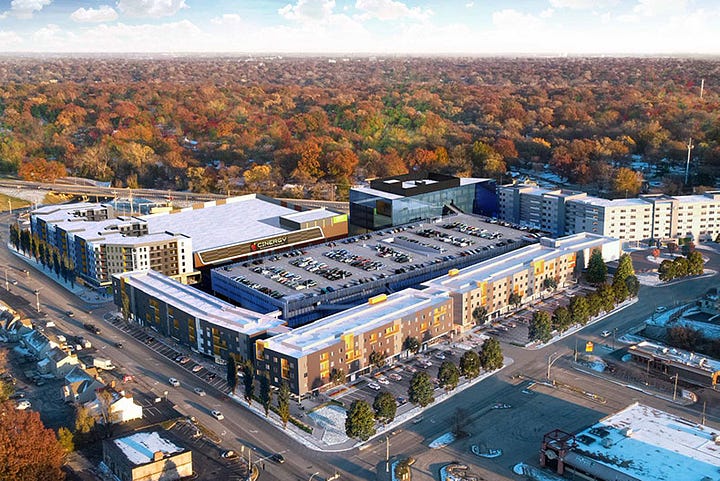
The Mission Gateway project has been trying to find its footing for eighteen years, since a very strange and small one-anchor shopping mall was demolished in 2005. The mall was not even two decades old when it was demolished. It was built in the heyday of indoor malls (replacing an earlier open-air mall), and probably was caught up in typical real estate hype cycles. In retrospect, it was obviously too small and too isolated to survive long-term.
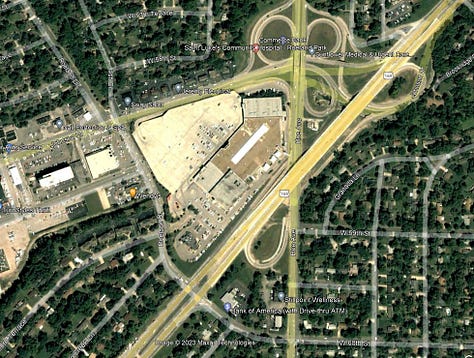
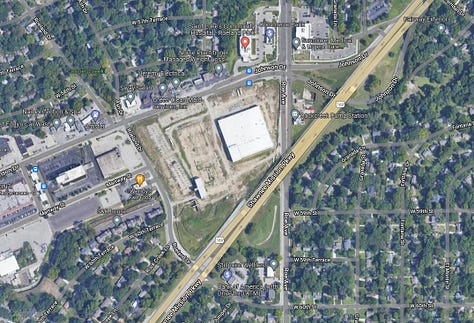
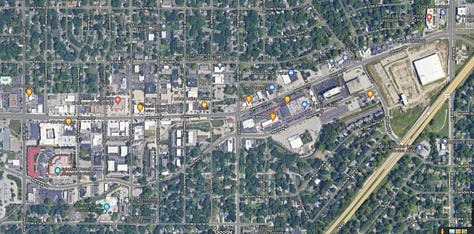
Since 2005, a developer and the city of Mission have been trying to get the site rebuilt. It’d be easy to say it has the feel of a cursed location. Here’s some recent history, as reported by the Shawnee Mission Post:
The lot has been vacant since the Mission Center Mall closed in 2005 and demolished the following year.
New York-based Cameron Group LLC has owned the property since then, but no project has been successfully completed in the years since, due to a number of reasons.
In the last year, economic impacts brought on by the COVID-19 pandemic have put a stop to construction of the Mission Gateway project.
The article details the many painful steps that have led to today, which include almost every possible difficulty that could happen in development. There have been financing issues, construction issues, weather delays, real estate recessions, problems getting tenants, and then, alas, the Covid lockdowns and subsequent disruptions.
It leads one to wonder, are curses real? Did the Bambino really curse the Red Sox for 100 years? Did the Billy Goat curse the Cubs? Could be.
In fact, this recent announcement comes during yet another very uncertain time in real estate, with skyrocketing interest rates, a recession looming, and major disruptions in the commercial real estate market. Someone asked a question about this on Twitter, and I offered a smart-ass response (isn’t this the only kind of response allowed on Twitter?)

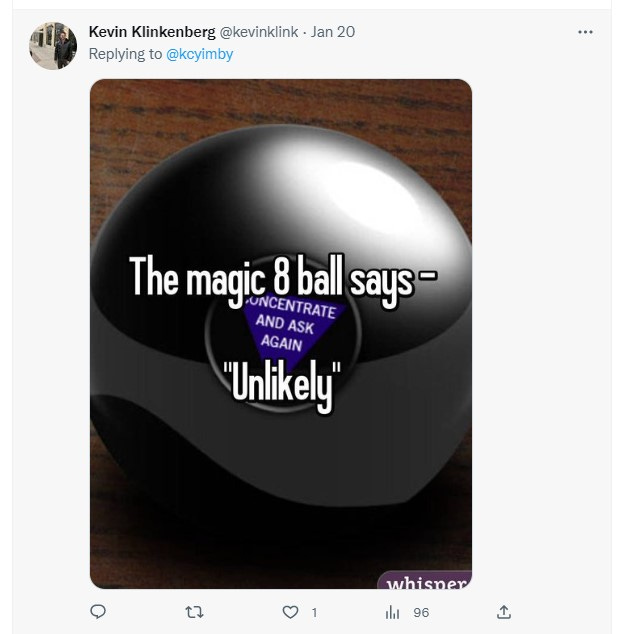
Look, I hope the people of Mission see success with this effort. I’d like for this site to be developed at last, and help the community remove a long-standing eyesore. So, don’t get me wrong. Maybe it’ll work this time. Maybe. But it’s worth talking about a project that has had nearly two decades of issues, and ask, “what if?” It might not make a difference on this site in Mission, but it might in some other location.
The Evil Developer
What is going on here? Are the problems of the last two decades in Mission just fate? A bad developer? Inept local government? A difficult real estate market?
Truth is, it could be any of those things, and all of them together.
Let’s talk first about what people usually gravitate towards, and that’s the “bad developer” narrative. This is the story the media usually loves, and what is often felt deeply by community members.
Developers are near the top of the list of convenient “black hat” figures. We all know this. Some developers actually embrace it. We’ve created a language and culture that makes it easy for laypeople to hate developers. They’re “ruining the neighborhood, putting profits over people, destroying our character, forcing people out” – you name it, the list goes on.
Developers are big boys and girls, and know part of the business is taking arrows. So, I’m not asking anyone to feel sorry for them. But, I would try in vain to ask people to understand what their world is like, and have some understanding and appreciation. After all, a developer almost certainly built just about every building you spend time in, every day.
Real estate development is as hard a business as exists. Yes, some people in the business make a lot of money doing it. Some revel in the flashy cars, the expensive suits and the “lifestyle.” In every city, you’ll find some developers that fit the stereotype. But more developers than people realize just make what is basically a middle class living. Most make less money than a typical corporate attorney. Some developers go completely broke trying to create a project. Real estate investors can lose big money on projects, and many developers get stopped in their tracks before starting. A vanishingly small percentage of projects ever come to fruition. Looming around every corner is the possibility of losing a LOT of money and enduring public shame.
Developers take on immense amounts of risk. Even the simplest projects can take a year or two to complete. Most take several years from conception to occupancy. Within that time span, the entire set of assumptions you made about the market, the site, the overall economy – it can all change.
Every project takes a lot of creativity, since you’re basically inventing something new each time. Sometimes that’s from a gut feel of what will work, sometimes it’s because of lots of diligent research. Often you just have to make decisions and go. And you have to know so much about so many aspects of life – financing, city approvals, neighborhood relations, design, construction details, maintenance, staffing and more.
It can be really fun. Seriously, it can. It’s a huge rush to conceive of a project and take it through to completion successfully. But it’s not easy, and it’s not for the faint of heart.
I’ve certainly had my criticisms over the years of what some developers do with their projects. A quick Google search, and you can find examples of me being not very kind about specific projects, or even contemporary development in general. There might, in fact, be a few who still hold grudges with me because of my outspokenness. So be it. At some point, I’ll write about how we Midwesterners are especially too willing to accept crappy design, and need to aspire to do much better. Hell, we could just look to what our grandparents’ and great-grandparents’ generations built.
But still, I have a deep appreciation for the work that people in development undertake every day. Like all fields of work, there are people with a wide range of talents and skills. Since it’s not an accredited, standardized field, you get people from all walks of life. I’ve worked with some that were true geniuses. I also know some that just basically lucked into making small fortunes. It’s a funny world – lots of very independent cats, impossible to herd.
Questions
This site in Mission is a very desirable location. Northeast Johnson County, Kansas has a lot of wealth. The land is very visible, along Shawnee Mission Parkway. It’s adjacent to a charming little mid-century main street strip. The city has worked diligently over a couple decades to make it more walkable, to add more people, and do all the things the planners recommend. Some of it has worked well, some hasn’t.
I’m sure I have many developer friends that would say there were problems with the chosen developer and their plans. I can’t speak to that, since I don’t know him personally, nor what challenges he’s had to overcome. From the outside looking in, it certainly seems like another developer could have executed better, or gotten something up and running by now.
But what if we asked different questions. What if the focus is not on the person we asked to solve all the site’s problems, and instead we asked ourselves, “are we the problem?” Have we created unreasonable expectations over the years about how development should take place, and created systems that just produce lousy results time and time again?
For example, was there a whole other way to think about developing this land? Whether it would have been purchased by the City, or done as a partnership with the City, what if a “small parcel” approach was used?
Why bother? Here’s something I noted in that earlier piece:
But I do believe public policy should seek to create a level playing field and opportunity for the many, not the few. Cities have an interest in diverse ownership, much like individuals have an interest in diversifying a retirement portfolio. Big projects by big developers are a perfect fit for the more mature phases of urbanization: long after markets have been established, long after the urbanism is working and when those developers can put their resources to work doing very large, mixed-use buildings (ideally still with reasonable footprints).
Truth is, the Mission Gateway project is one version of what I called The Urban Experiment. And, it perfectly illustrates the downside of the approach: eighteen years worth of downside; eighteen years of this land returning nothing to the City, and being a drag on activity and values for the neighbors. If the current proposal comes to fruition, that’s a twenty year timeline for the project. Children will have been born and graduated high school with this site being devoid of productive use their whole lives.
Thinking Small
What else could be done in a twenty year cycle? How much small-lot development could happen? Imagine the original plan was to create a couple streets, a small public space, and a few blocks. If, over the last twenty years, only five parcels per years were bought and built upon, that’d now be 100 buildings on the site. In the good years, that number might’ve been 10 or 15. In the bad years, zero. But after a couple decades, it would feel like a mostly complete little community. And it would likely feature a rich mixture of businesses, both large and small, local and not local. It would have the opportunity to be a much more natural tie-in to the adjacent main street strip. And it probably wouldn’t be on its third round of development incentives.
I’ve worked on some really large master-planned projects over the years, with some really great developers. These are people I’ve liked, admired, and usually under-charged with my fees because I loved the work so much. They were all very capable, experienced and successful people.
Here’s a rundown for a few on how it started, and how it’s going:
New Longview. Planning in 2001, about 50-60% built.
Lenexa City Center. Original planning in 2001, about 70% built.
AkSarBen Village. Original planning in 2002, about 80% built.
New Town St Charles. Original planning in 2003, about 80% built.
There’s a much longer list of elegantly planned projects that never saw the light of day, mostly because of economic cycles.
This stuff is really hard. Some large, master-planned projects work out really well for everyone involved, even if they take a couple decades. There’s plenty of Master Planned Communities in suburban areas that timed it all just right, nailed the market, and produced quality places. There are urban experiments that have also threaded the needle just so.
But I still can’t help but wish more of us would look to other possible models. We have great examples of communities planned for the long-term, but built incrementally. In fact, that’s nearly all of America before the city planning movement and the rise of zoning and its highly managed approach to development.
So much of what happens in the professional world, regardless of whether it’s public or private sector, is just inertia. We have ways of doing things, that build upon themselves and repeat, for years. Sometimes those methods work well. More often than not, they don’t. Pretty typically they lead to the mediocre built environment we are all familiar with. But, the private sector and public sector actors just persist, regardless of what happened last time. We may lament what we are producing, but no one involved is sufficiently motivated to make waves. Enough people have a job somewhere in the system, and thus a salary, and so we don’t like to ask hard questions. After all, the problem can’t possibly be us, can it?
So, The Urban Experiment just rolls on.


